If you were starving and came upon a patch of cattails you would have great cause for celebration. You have found food, and water. You will survive. But if you are not starving and do not have all the time in the inter-connected world you just might find cattails highly overrated.
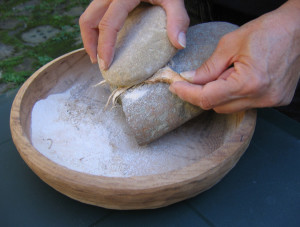
Cattail starch extraction by hand takes time and calories. Photo by Zubacorp
It is true that no plant can produce more starch per acre than cattails, about 3.5 tons under cultivation. And it can produce a lot of starch economically if you can mechanize the extraction. But hand extraction is time consuming and labor intensive. It is also wet, smelly work all of which can be worsened significantly by harvesting in cold weather. So yes, cattails are food but the time demand is such that harvesting food has to be your prime occupation.
A similar argument can be made for kudzu. The roots do have edible starch but it takes a gargantuan amount of work to get the starch out, literally hours of steady pounding. It is not a calorie positive activity. It moves you closer to starvation. But, mechanize the process with some hammers run by falling water — or hammers run by a horse fed on an endless supply of grass — and it becomes a reliable calorie-positive food.
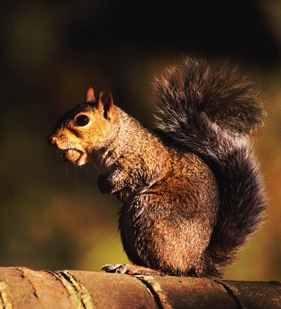
Even squirrels avoid the most tannin-laden part of the acorn. Photo by Sumpretty
Just how good are these wild “staples” came up in a foraging class this weekend when it was asked why did the Native Americans eat acorns when they need so much processing? There can be several answers. One is the natives had no choice and they had a lot of time to process acorns. It was their 9-to-5 job, so to speak. Another is acorns are nutrient dense and have fat which is not only nice but essential to have if you can’t run down a buffalo. A third answer is variety. The menu only changed with the season so variety was important. One could also add that acorns, if care for, store well for a few years making a food bank one could rely on.
All these foods if approached efficiently are calorie positive. But they take time and calories to make edible. Another variable is whether the food is for one on the run or for a group in a settled situation. It makes a difference. Personally I look for shortcuts. I roast the cattail root reducing the labor and time needed significantly. I look for Live Oaks (white oaks)that have acorns with minimal tannin thus requiring less work. And I reduce that work by crushing the nutmeat in an oil expeller first. This extracts the oil and mashes up the acorns so they leach faster and more completely. Having a nutsheller to shell them also reduces hours of work down to minutes. As for kudzu I look for little roots the size of my fingers, or I feed the leaves to goats and let them turn it into something easier to work with, such as milk.
Some wild food requires little work some a lot. Much of what comprises success with wild foods is knowing the difference and the most efficient way to harvest a particular food. Still interested? Here’s an article on “wild’ flours.
While seasonal changes are not as dramatic in warmer climates we definitely do have them regarding plants. Pellitory is all but gone for the season. We shouldn’t smell its cucumber-like aroma again until Thanksgiving or so. Sow Thistles are reaching the end of their season as well. Most are past the stage of eating. On the gangbuster side are Blackberries and Creeping Cucumbers. Blackberries will be done soon the the cukes will keep on producing until a fall frost, freeze or the really short days of the winter solstice. Dare I also mention we are getting our first crop of Black Nightshade berries, Solanum americanum. I have yet to make a pie out of them — I really don’t like to bake — but I eat the berries all the time as a trailside nibble. Just make absolutely sure they are ripe. And in reference to ripe our Lantana berries are not in season yet and are still toxic green. That’s another berry that must be totally ripe before one eats it.
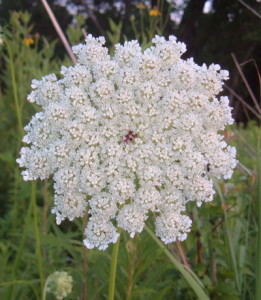
Wild Carrot, photo by Ilovequeenanneslace.com.
Giant Hog Weed which turned out to be Queen Anne’s Lace, Pine Pollen’s Up, Unidentified Animate Object, I call her Needles, Help on ID, Bamboo, Bay Foraging, Yellow/Pink Pyracantha, and Foraging Safety Tips… all were recent discussions on the Green Deane Forum. On the Forum we post messages and pictures about foragering all year long. There’s even a UFO page for Unidentified Flowering Objects so plants can be identified. The link to join the forum is on the right hand side of this page.
Upcoming foraging classes are always being updated on my “classes” page (see button above.) Some dates are yet to be scheduled. Saturday, May 17th Mead Garden, 1500 S. Denning Dr., Winter Park, FL 32789, 9 a.m. Saturday, May 24th, Bayshore Live Oak Park, 23000 Bayshore Rd., Port Charlotte, 33980, 9 a.m. Sunday, May 25th, at John Chestnut Park, 2200 East Lake Road, Palm Harbor, FL 34685. 9 a.m
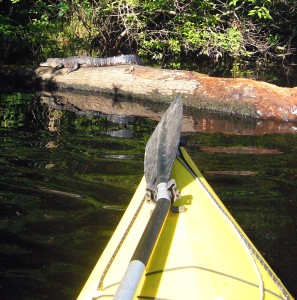
You won’t see alligators on my foraging videos like this little one seen on Rock Spring Run, Florida. Photo by Green Deane
My foraging videos do not include alligators but they do cover dozens of edible plants in North America. The set had nine DVD. Each DVD has 15 videos for 135 in all. Some of these videos are of better quality than my free ones on the Internet. They are the same videos but many people like to have their own copy. I burn and compile the sets myself so if you have any issues I handle it. There are no middle foragers. And I’m working on adding a tenth DVD. To learn more about the DVDs or to order them click here.
Answers to What Do You See #13 had four edible species. This is a very common sight in scrub areas locally. 1) Is wild blueberries. 2) Is wild grapes. 3) Is gallberry. The berries of this species are not edible but the leaves make a nice caffeine-less tea. 4) Is a young Smilax, but whether the root is large or small would require some digging.
To donate to the Green Deane Newsletter click here.

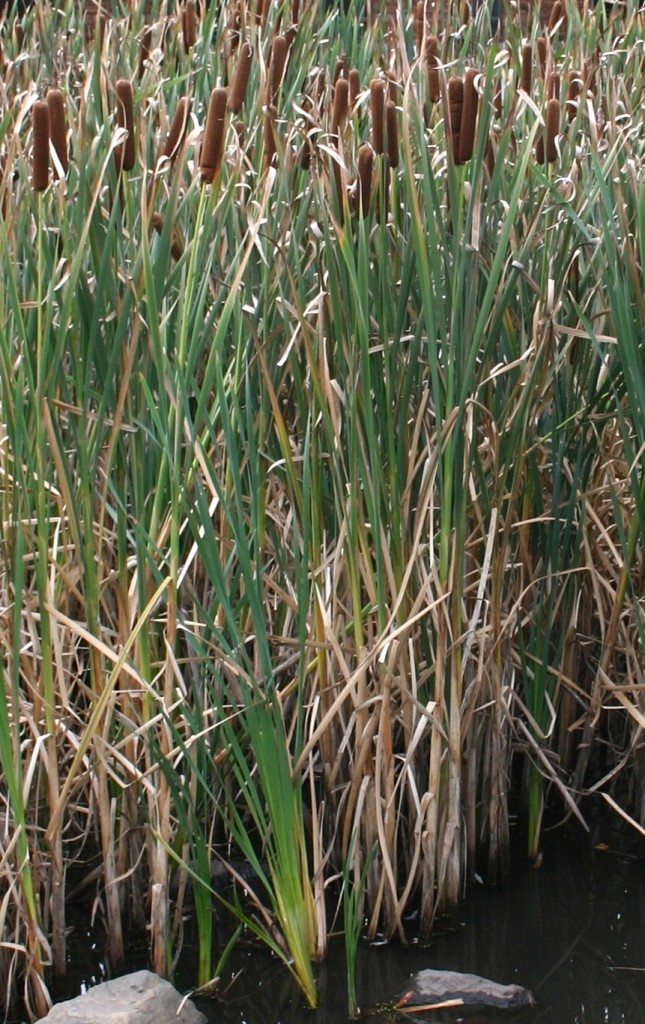
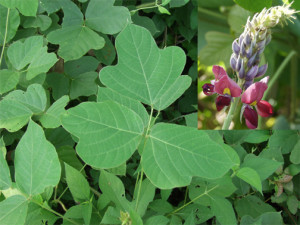

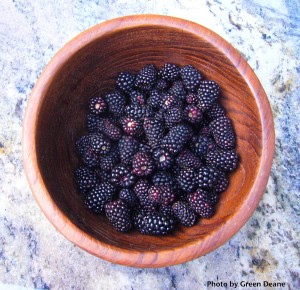
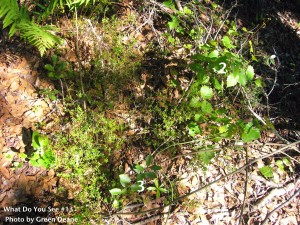

I have eaten cattails and did not find them at all labor intensive. My family has made several cups of wet flour at one time from the tubers in a matter of minutes. I learned how to use and cook cattails (and many other things that were actually tasty to eat) from ‘Stalking the Wild Asparagus,’ a book by Euell Gibbons, the “wild hicory nut” guy.
Hold tuber with both hands over a bowl under a small light stream of running water and use a scrubbing motion (like scrubbing stained clothing); the fine flour releases in seconds. Just most of the water from the bowl and put into a jar. Refrigerate if not using immediately. Use the way you would use flour to which liquid has already been added (like adding powdered milk and/or eggs for example). I suppose you could dry it and then pound it into powder again,…but why?
The corms, the small, flat swollen part between the tuber and leaves, is great raw and sliced into salads (kind of like water chestnuts), or added to stir-fried dishes.
In spring, when the young leaves have emerged, grab central leaves (that haven’t completely separated from each other yet) and pull upward to slip them from the center of the plant. Raw, they remind me of cucumber, and lightly cooked, of zuchinni.
Remove the young, green, unwrapped and undeveloped ‘tails’ at the top of the stem and steam. Butter and eat them like tiny corn on the cob; the taste reminds me of prime asparagus!
The natives used the entire plant, and I think they really WERE onto something great! 🙂
In the early spring we had the largest dewberry (Blackberry) bloom in coastal Mississippi that I have seen in years. Some of my favorite patches looked like a heavy snowfall with all the white blossoms. I waited in great anticipation for the weeks to pass so I could freeze berries, make preserves, and my favorite blackberry cobler. Just as the berries were getting ripe enough to pick we had torenmtial rains for several days. Not only many inches of total rainfall, but huge heavy drops on several occassions. When I went out after the rains ended to pick berries there were more berries on the ground than on the vines. Rain has desimated my wild crop of berries. In two days of picking and searching and a lot of hard work I have barely enough to make one cobbler. By the way, just an observation , but the bowl of berries in the photo look more like mullberries than blackberries for some reason.
Best regards to all fellow foragers.
Chaaz Mikell
Do I remember correctly that a tea made from queen anns’ lace is a good insect repellant for garden plants?
I like very much the way of thinking of alternatives as said e.g. roasting, crushing, or feeding to goats in the case of those staple “famine” foods: Cattails, acorns and kudzu. By analogy, and in general, many problems could be resolved if people bear in mind alternatives as such when referring to “efficiency” related to matters of everyday life. Speaking of famine foods, it is really sad , as recent news has been told, that some of my people in western Sudan, due to unrest and lack of peace, are digging ant-heaps in search of food. It is added information to me to know that Cattails (Typha latifola) are useful in waste water treatment. About seasonal change, we , here in my country, witness such change prior to our rainy season. This is reflected in a vegetable – though not absolutely wild – market rich in almost yellow lemons, palm dates – ripened ; but not dried. A lot of lemons and dates fall off freely from the trees because of winds – a sign that the rainy season is approaching. Also the market is full of Cucumber (vernacular “Aggour pronounced “Adjour” vis. C. melo flexuosus) . This is nowadays very cheap due to abundance. About a month later, specifically during the month of muslim fasting “Ramadan”, it will become very costly because of the high demand, as it is consumed intensively in preparing a delicious type of salad when mixed with sour milk called “Roab” or yougart ,minced garlic, pepper and salt.